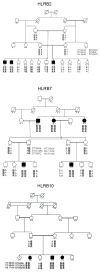SLC26A4 mutations in patients with moderate to severe hearing loss
- PMID: 23504402
- PMCID: PMC3714363
- DOI: 10.1007/s10528-013-9582-0
SLC26A4 mutations in patients with moderate to severe hearing loss
Abstract
Mutations in SLC26A4 cause either syndromic or nonsyndromic hearing loss. We identified a link between hearing loss and DFNB4 in 3 of the 50 families participating in this study. Sequencing analysis revealed two SLC26A4 mutations, p.V239D and p.S57X, in affected members of the 3 families. These mutations have been previously reported in deaf individuals from the subcontinent, all of whom manifested profound deafness. The patients investigated in our study exhibited moderate to severe hearing loss. Our results show that inactivating SLC26A4 mutations that cause profound deafness can also be involved in the etiology of moderate to severe hearing loss. The type of mutation cannot predict the severity of the hearing loss in all cases, and there may be additional epistatic interactions that could modify the phenotype.
Figures



References
-
- Albert S, Blons H, Jonard L, Feldmann D, Chauvin P, Loundon N, Sergent-Allaoui A, Houang M, Joannard A, Schmerber S, Delobel B, Leman J, Journel H, Catros H, Dollfus H, Eliot MM, David A, Calais C, Drouin-Garraud V, Obstoy MF, Tran Ba Huy P, Lacombe D, Duriez F, Francannet C, Bitoun P, Petit C, Garabedian EN, Couderc R, Marlin S, Denoyelle F. SLC26A4 gene is frequently involved in nonsyndromic hearing impairment with enlarged vestibular aqueduct in Caucasian populations. Eur J Hum Genet. 2006;14:773–779. - PubMed
-
- Anwar S, Riazuddin S, Ahmed ZM, Tasneem S, Ateeq ul J, Khan SY, Griffith AJ, Friedman TB, Riazuddin S. SLC26A4 mutation spectrum associated with DFNB4 deafness and Pendred’s syndrome in Pakistanis. J Hum Genet. 2009;54:266–270. - PubMed
-
- Campbell C, Cucci RA, Prasad S, Green GE, Edeal JB, Galer CE, Karniski LP, Sheffield VC, Smith RJ. Pendred syndrome, DFNB4, and PDS/SLC26A4 identification of eight novel mutations and possible genotype-phenotype correlations. Hum Mutat. 2001;17:403–411. - PubMed
-
- Choi BY, Kim HM, Ito T, Lee KY, Li X, Monahan K, Wen Y, Wilson E, Kurima K, Saunders TL, Petralia RS, Wangemann P, Friedman TB, Griffith AJ. Mouse model of enlarged vestibular aqueducts defines temporal requirement of Slc26a4 expression for hearing acquisition. J Clin Invest. 2011;121:4516–4525. - PMC - PubMed
Publication types
MeSH terms
Substances
Grants and funding
LinkOut - more resources
Full Text Sources
Other Literature Sources

